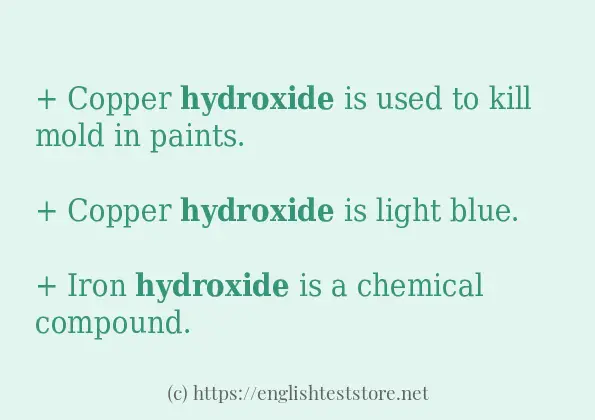How to use in-sentence of “hydroxide”:
+ Copper hydroxide is used to kill mold in paints.
+ Copper hydroxide is light blue.
+ Iron hydroxide is a chemical compound.
+ The hydrogen is released and the hydroxide bonds with the sodium to make sodium hydroxide.
+ This means that the hydroxide ion attacks the carbon atom from the other side, exactly opposite the bromine ion.
+ Lithium hydroxide is corrosive, like the other alkali metal hydroxides.
+ It is made by heating white phosphorus in sodium hydroxide solution.
+ Potassium arsenate is made by reacting amounts of potassium hydroxide with arsenic acid.

Example sentences of “hydroxide”:
+ In lateritic bauxite, the aluminum hydroxide contained in laterite deposits is almost entirely a form called gibbsite.
+ Thallium hydroxide is a yellow solid.
+ It is named after soda, a name for sodium hydroxide or sodium carbonate.
+ Lithium hydroxide is very corrosive.
+ Sodium hydroxide is used in industry as a strong base, potassium hydroxide is used in agriculture, and iron hydroxide minerals such as goethite and limonite have been used as iron ore.
+ It has a basic electrolyte, usually potassium hydroxide or sodium hydroxide.
+ In lateritic bauxite, the aluminum hydroxide contained in laterite deposits is almost entirely a form called gibbsite.
+ Thallium hydroxide is a yellow solid.
+ It reacts with water to make a mixture of sodium hydroxide and sodium hydroselenide.
+ Therefore, hydroxide ions are heavily involved in acid-base reactions.
+ It can be made by mixing lithium oxide or lithium hydroxide and carbon dioxide.
+ Potassium hydroxide is used as an electrolyte.
More in-sentence examples of “hydroxide”:
+ It is made by dissolving iodic acid or iodine in sodium hydroxide solution.
+ In the example below, the oxygen of the hydroxide ion donates an electron pair to bond with the carbon at the end of the bromopropane molecule.
+ Potassium iodate is made by reacting iodic acid with potassium hydroxide or by reacting iodine with potassium hydroxide.
+ It is made by dissolving iodic acid or iodine in sodium hydroxide solution.
+ In the example below, the oxygen of the hydroxide ion donates an electron pair to bond with the carbon at the end of the bromopropane molecule.
+ Potassium iodate is made by reacting iodic acid with potassium hydroxide or by reacting iodine with potassium hydroxide.
+ A dilute solution of sodium hydroxide was used so the zinc hydroxide didn’t dissolve.
+ Lithium bromide is made by treating an aqueous solution of lithium carbonate with hydrobromic acid or by reacting lithium hydroxide with bromine.
+ It can be made by reacting sodium hydroxide with a bismuth chloride.
+ Sodium arsenite is made by reacting sodium hydroxide with arsenic trioxide.
+ It is made by reacting a basic solution of bismuth oxide and sodium hydroxide with a strong oxidizing agent.
+ Hydrogen and sodium hydroxide are produced.
+ It does not dissolve in potassium hydroxide or concentrated ethanol.
+ Calcium nitrate is made by reacting calcium hydroxide or calcium carbonate with nitric acid.
+ Industrially, sodium acetate trihydrate is prepared by reacting acetic acid with sodium hydroxide using water as the solvent.
+ It reacts with sodium hydroxide or potassium hydroxide to make copper hydroxide.
+ It reacts with water to make lithium hydroxide and ammonia.
+ It is made by reacting potassium hydroxide and sulfuric acid.
+ Zinc hydroxide is used to absorb blood in large bandages.
+ An Arrhenius base is a substance that when solvationdissolved in an aqueous solution, it produces hydroxide ions.
+ But it is normally made artificially by reacting sodium hydroxide and nitric acid.
+ Zinc hydroxide can be made by reacting zinc chloride or zinc sulfate with sodium hydroxide.
+ It may be made by dissolving bromine in hot sodium hydroxide solution.
+ This is because it reacts with air to form sodium hydroxide and sodium carbonate.
+ Barium hydroxide is a white solid.
+ Sodium selenate is made by reacting sodium hydroxide with selenic acid.
+ Zinc hydroxide is found as a few rare minerals.
+ If too much sodium hydroxide is used, sodium disulfite is made instead.
+ Sodium phosphite is made by reacting sodium hydroxide with phosphorous acid.
+ The potassium hydroxide or potassium chloride has to be melted at a very high temperature.
+ It is made by reacting sodium hydroxide with carbon dioxide or by heating sodium bicarbonate.
+ It can be made by reacting cobalt, cobalt hydroxide with sulfuric acid.
+ It makes a hydroxide that in a strong base when dissolved in water.
+ Copper hydroxide can be made by reacting copper sulfate with sodium hydroxide.
+ In the battery, zinc is oxidationoxidized by manganese dioxide in a potassium hydroxide electrolyte.
+ It is made by reaction of a little sodium hydroxide with phosphoric acid.
+ Potassium hydroxide is also produced.
+ Sodium hydroxide is used in factories as an alkali, potassium hydroxide is used in farming, and iron hydroxide have been used as low grade brown iron ore.
+ It also can be made by reacting nickel hydroxide with hydrochloric acid.
+ Lithium hydroxide is used to make lithium greases.
+ Lithium hydroxide is a chemical compound.
+ It is made by combining sodium hydroxide and phosphoric acid.
+ A hydronium ion will give up its proton to a hydroxide ion, forming two molecules of HO, which is neutral.
+ The blue form is made by reacting ammonium hydroxide with cobalt hydroxide.
+ It has iron and hydroxide ions in it.
+ When it is in a chunk, it starts reacting slowly because calcium hydroxide makes a coating that does not dissolve on the calcium.
+ Nickel hydroxide is used in the nickel cadmium battery and the nickel-metal hydride battery.
+ Barium hydroxide is corrosive because it is basic.
